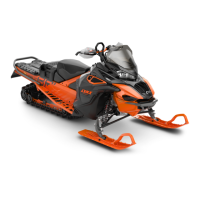39
ENGLISH
* Check fuel and injection oil for levels and leaks. Replenish as necessary and
see an authorized Lynx dealer in case of any leaks.
* Verify that air filter(s) is free of snow, if so equipped.
* Make certain your snowmobile is pointed away from people or objects before
you start it.
* Be warmly dressed with clothing designed for snowmobiling.
Operating instruction
Propulsion
Depressing throttle lever increases engine RPM causing the drive pulley to enga-
ge. Depending on models engine RPM must be between 2500 and 4200 before
drive pulley engagement will occur.
Outer sheave of drive pulley moves toward inner sheave, forcing drive belt to move
upward on the drive pulley and simultaneously forcing the sheaves apart on the
driven pulley.
The driven pulley senses the load on the track and limits the belt movement. The
result is an optimized speed ratio between engine RPM and the speed of the
vehicle at any time.
Power is transferred to the track through the chaincase or gearbox and drive axle.
Turning
Handlebar controls the steering of the vehicle. As the handlebar is rotated to right
or left, the skis are turned right or left to steer the snowmobile.
Stopping
Before riding your snowmobile, you should understand how to stop it. This is
done by releasing the throttle and gradually depressing the brake lever on the left
side of the handlebar.
In an emergency, you may stop your vehicle by pressing the engine cut-out
switch located near the throttle control and applying the brake.
Remember, a snowmobile cannot stop on a dime. Braking characteristics vary
with deep snow, packed snow or ice. If the track is locked during hard braking,
skidding may result.
Starting the engine
Check throttle lever operation.
Ensure that the engine cut-out switch is in the ON position.
Ensure that the tether cord cap is in position and that the cord is attached to your
clothing eyelet.

